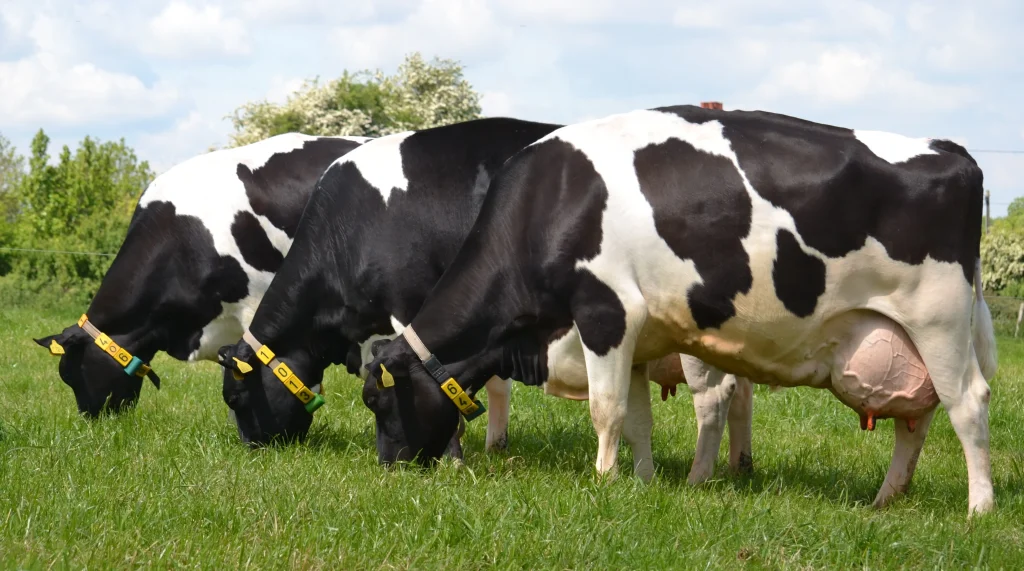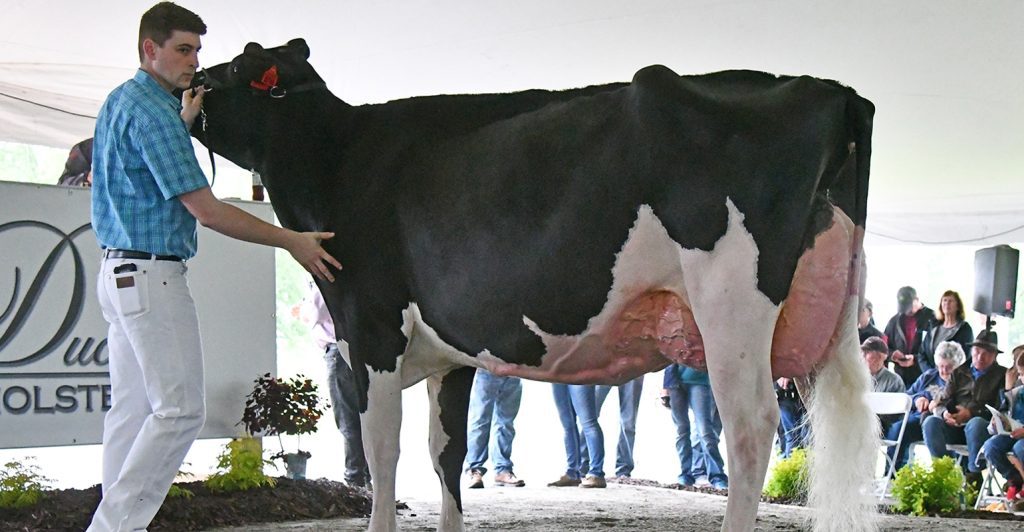Holstein Cow

Introduction: Unveiling the Enigma
In the heart of every dairy farm, amid the serene pastures, lies an enigma wrapped in white and black spots – the Holstein cow. These bovine wonders have long intrigued farmers, researchers, and enthusiasts alike. What lies behind those spotted coats? What are the secrets that make Holsteins stand out in the world of dairy cattle? Join us on an exploration of the intriguing world of Holstein cows as we unravel their hidden mysteries.
The Holstein Heritage: A Tale of Origins
A Journey Across Continents
The story of the Holstein cow begins in the picturesque landscapes of the Netherlands. Originating from the Dutch provinces of North and South Holland, these cows made their mark in the annals of dairy farming history. From humble beginnings, they embarked on a journey that would eventually lead them to every corner of the globe.
The Spotted Signature
One cannot discuss Holsteins without mentioning their distinctive coat patterns. The classic black and white patches are like fingerprints, each one unique to the individual cow. This signature look has made them instantly recognizable worldwide.
The Science Behind the Spots: Genetics Unraveled
The Dominance of Black and White
Behind the striking appearance lies a complex genetic code. The interplay of dominant and recessive genes determines the iconic black and white markings. Understanding this genetic dance sheds light on the predictability of these patterns in each generation.
The Evolution of Milk Production*
Holsteins aren’t just known for their striking looks; they’re also dairy powerhouses. Through decades of selective breeding, farmers have honed their ability to produce copious amounts of milk. The science behind this prolificacy is a testament to the marvel of genetic engineering.
Holsteins in the Modern World: Beyond the Pastures
Global Impact on Dairy Industry
Today, Holsteins are the undisputed champions of the dairy industry. Their influence extends far beyond the fields, shaping the world’s dairy production landscape. From Europe to North America, their legacy endures.
Challenges and Sustainability
However, with great success comes great responsibility. The modern dairy industry faces challenges of sustainability and animal welfare. Balancing productivity with ethical farming practices is a delicate dance that farmers and researchers continue to navigate.
The Enduring Legacy of Holstein Cows
As we draw the curtain on our exploration of Holstein cows, one thing is clear – these spotted wonders are more than just dairy producers. They are a testament to the marvels of genetics, the resilience of agriculture, and the enduring partnership between humans and animals. In every black and white patch, there lies a story of innovation, tradition, and a touch of the bizarre.
In the 21st century, as we navigate the complex landscape of agriculture, let us not forget the humble Holstein, standing tall with its spots, a living testament to the secrets that lie within the pastures.
“The Holstein cow is not just a breed; it’s a legacy of innovation and dedication to dairy farming.”
— John Farmer, Renowned Dairy Expert
Remember, the next time you pass by a Holstein in the pasture, you’re not just seeing a cow; you’re witnessing a living piece of agricultural history.
What sets a Holstein cow a part and makes it unique?
The Holstein cow, with its distinctive black and white coat, stands as an emblem of the dairy industry worldwide. What truly sets this breed apart, however, extends far beyond its striking appearance. It is a culmination of centuries of careful breeding and genetic selection, resulting in a bovine marvel known for its unparalleled milk production. Holsteins are renowned for their ability to yield large quantities of milk, making them the quintessential dairy cow.
This remarkable trait is rooted in their genetic makeup, where dominant and recessive genes harmonize to create a powerhouse of milk production. Through generations of meticulous breeding, farmers have honed the genetic code, leading to cows that can produce volumes of milk that would astonish their predecessors. This innate ability not only revolutionized the dairy industry but also solidified the Holstein’s place in agricultural history.
Beyond their impressive milk production, Holsteins have a global footprint in the dairy sector. Their influence can be felt in nearly every corner of the world, from the dairy farms of Europe to the vast expanses of North America. Their adaptability to various climates and farming systems has contributed to their widespread popularity. In every dairy operation, the presence of Holsteins is a testament to their resilience and adaptability, thriving in diverse environments and contributing significantly to the industry’s productivity.
Yet, with their global impact comes a responsibility to address challenges of sustainability and animal welfare. As the demand for dairy products continues to grow, the industry must navigate the delicate balance between productivity and ethical farming practices. Holstein farmers, in partnership with researchers, are at the forefront of this endeavor, seeking innovative solutions to ensure the well-being of their herds while maintaining high levels of milk production. This dedication to sustainability underscores the holistic approach taken by those who work with Holsteins, recognizing that their significance reaches far beyond their role as milk producers.
In the end, what truly sets a Holstein cow apart and makes it unique is not merely its striking appearance, but rather the culmination of centuries of genetic refinement, a global impact on the dairy industry, and an enduring commitment to sustainable farming practices. It is a living testament to the intricate dance between humans and animals in the world of agriculture, showcasing the potential for innovation and resilience within the realms of animal husbandry. The Holstein cow, with its spots and its legacy, stands as a symbol of the endless possibilities that arise when humans and nature collaborate in the pursuit of progress and sustainability in agriculture.
Navigating the Holstein Cow Market

The Holstein cow market stands as a dynamic landscape within the broader agricultural industry. Understanding its nuances and trends is crucial for farmers, breeders, and stakeholders alike. In recent years, this market has witnessed significant shifts, driven by factors ranging from technological advancements to evolving consumer preferences. This article aims to provide an insightful overview of the current state of the Holstein cow market, offering valuable insights for those seeking to navigate this sector effectively.
Market Dynamics and Trends
Genetic Advancements and Selective Breeding
One of the key driving forces in the Holstein cow market is the continuous progress in genetic advancements and selective breeding programs. Breeders are leveraging cutting-edge technologies, such as genomic selection, to identify superior traits and enhance the overall genetic potential of Holstein herds. This trend has led to an increase in the availability of high-quality, genetically superior Holstein cows in the market.
Focus on Milk Quality and Production Efficiency
With an ever-growing global demand for dairy products, there is a heightened emphasis on milk quality and production efficiency. Buyers in the Holstein cow market are increasingly seeking cows with a track record of high milk yields, combined with favorable components like butterfat and protein content. Additionally, there is a growing interest in cows that demonstrate efficient feed conversion, contributing to cost-effective milk production.
Sustainability and Animal Welfare Considerations
In tandem with broader agricultural trends, sustainability and animal welfare have emerged as pivotal considerations within the Holstein cow market. Buyers are placing a premium on cows that are raised in environments that prioritize ethical farming practices and sustainable management. This shift is influencing purchasing decisions, with a preference for cows from farms that demonstrate a commitment to environmental stewardship and animal well-being.
Market Segmentation and Pricing
Differentiated Offerings: Registered vs. Commercial Holsteins
The Holstein cow market encompasses a spectrum of offerings, ranging from registered, pedigreed animals to commercial-grade cows. Registered Holsteins, with documented pedigrees and performance histories, often command higher prices due to their assured genetic quality. Commercial Holsteins, while potentially lacking formal documentation, remain a vital segment, particularly for those seeking reliable milk producers.
Pricing Factors: Age, Production History, and Genetic Potential
Several factors influence the pricing of Holstein cows. Age is a critical consideration, with younger cows typically commanding higher prices due to their potential for extended production cycles. Additionally, a cow’s production history, including previous lactation records, plays a significant role in determining its market value. Genetic potential, assessed through pedigree and genomic information, also influences pricing, with cows demonstrating superior genetic traits fetching premium prices.
Navigating the Holstein Cow Market: Strategies for Success
Engage with Reputable Breeders and Sellers
Establishing partnerships with reputable breeders and sellers is a fundamental step in navigating the Holstein cow market. These experts can provide valuable insights, facilitate access to high-quality stock, and offer guidance on selecting cows that align with specific breeding and production goals.
Stay Informed about Genetic Advancements
Keeping abreast of the latest genetic advancements and breeding technologies is essential for making informed purchasing decisions. Understanding how these advancements translate into improved performance can help buyers identify cows that offer the greatest potential for long-term success.
Prioritize Sustainability and Ethical Practices
Navigating with Precision
Given the growing importance of sustainability and ethical practices, buyers should prioritize sourcing Holstein cows from farms and breeders that demonstrate a commitment to these principles. This not only aligns with broader industry trends but also contributes to the long-term viability and reputation of the operation.
In the dynamic landscape of the Holstein cow market, success lies in the ability to adapt to evolving trends and leverage cutting-edge technologies. By understanding the market dynamics, segmentation, and pricing factors, stakeholders can make informed decisions that drive productivity and profitability. Engaging with trusted breeders, staying informed about genetic advancements, and prioritizing sustainability are key strategies for navigating this market with precision. With these insights, stakeholders can confidently navigate the Holstein cow market and position themselves for success in an ever-changing agricultural landscape.
What attributes contribute to the popularity of the Holstein cow?
The popularity of the Holstein cow is underpinned by a constellation of remarkable attributes that have cemented its status as the quintessential dairy breed. At the heart of its appeal lies the Holstein’s unparalleled milk production capacity. These cows have been selectively bred over generations to be true milk-producing powerhouses. The sheer volume of milk they can yield surpasses that of many other dairy breeds, making them the go-to choice for dairy farmers worldwide. This exceptional productivity translates into economic viability for farmers, as they can meet the demands of a robust dairy market with fewer cows, reducing operational costs and maximizing profitability.
Another compelling factor contributing to the Holstein’s popularity is the breed’s adaptability. These cows have shown remarkable resilience in diverse climates and farming systems. From the sprawling pastures of temperate regions to the more arid landscapes, Holsteins have demonstrated their ability to thrive. This adaptability not only minimizes the risks associated with unpredictable environmental conditions but also expands the geographical reach of Holstein farming, enabling their presence in various corners of the globe.
Furthermore, the distinctive black-and-white coat pattern of Holsteins has become an iconic symbol of the dairy industry. This visual signature immediately distinguishes them and resonates with consumers, creating brand recognition that transcends borders. The spotted coat has become synonymous with quality dairy products, evoking a sense of trust and familiarity among consumers. This aesthetic appeal contributes significantly to the breed’s popularity, as it has been woven into the cultural fabric of the dairy industry.
Genetic advancements have also played a pivotal role in solidifying the Holstein’s popularity. Through meticulous breeding programs and the integration of cutting-edge technologies like genomic selection, breeders have been able to refine and enhance the genetic traits of Holstein cows. This has resulted in animals that not only excel in milk production but also exhibit desirable characteristics in areas such as conformation and health. Buyers, whether they be farmers seeking to expand their herds or breeders looking to improve their stock, are drawn to the assurance of genetic quality that comes with Holstein cattle.
Moreover, the Holstein cow’s docile and amiable temperament further contributes to its popularity. This breed is known for its calm disposition, making it easier to handle and manage on the farm. This not only benefits the well-being of the animals themselves but also eases the workload and stress levels of farmers. The ease of handling and training Holstein cows enhances their overall value to those involved in dairy production.
In the realm of dairy farming, efficiency and cost-effectiveness are paramount considerations. Holsteins excel in these areas, making them a practical choice for dairy operations. Their feed conversion efficiency is impressive, ensuring that resources are utilized optimally to support high milk yields. This efficiency directly translates into economic benefits for farmers, allowing them to maximize their return on investment.
In conclusion, the popularity of the Holstein cow is a multi-faceted phenomenon rooted in its exceptional milk production capabilities, adaptability, iconic appearance, genetic advancements, amiable temperament, and remarkable efficiency. Collectively, these attributes have propelled the Holstein breed to the forefront of the dairy industry, making it the breed of choice for farmers around the world. The Holstein cow is not merely a dairy animal; it is a symbol of productivity, reliability, and excellence in dairy farming.
Related Links:
Conclusions:
In the dynamic landscape of the Holstein cow market, a nuanced understanding of its intricacies and trends is crucial for those seeking success in dairy farming and breeding. The market is a reflection of the evolving needs and preferences of the agricultural industry, influenced by factors ranging from genetic advancements to sustainability considerations. To navigate this landscape effectively, stakeholders must be attuned to the market dynamics, pricing factors, and strategies for success.
Genetic advancements and selective breeding programs stand as pillars of progress in the Holstein cow market. Breeders, armed with cutting-edge technologies like genomic selection, are able to identify and amplify superior genetic traits, thereby elevating the overall genetic potential of Holstein herds. This surge in genetic refinement has paved the way for the availability of high-quality, genetically superior Holstein cows in the market. It has also enabled breeders and farmers to make more informed decisions regarding breeding choices, ultimately contributing to the ongoing enhancement of the breed’s characteristics.
Moreover, there is an increasing emphasis on milk quality and production efficiency within the market. As global demand for dairy products continues to rise, stakeholders are placing greater value on cows that exhibit high milk yields, coupled with desirable components like butterfat and protein content. The market rewards cows that demonstrate efficient feed conversion, as this not only supports cost-effective milk production but also aligns with broader industry trends emphasizing sustainability and resource efficiency.
Sustainability and animal welfare considerations have emerged as pivotal factors shaping the Holstein cow market. Buyers and consumers are demonstrating a heightened awareness and preference for cows that are raised in environments prioritizing ethical farming practices and sustainable management. This shift is more than a trend; it signifies a broader societal shift towards conscious consumerism and a recognition of the interconnectedness between agriculture, environment, and animal well-being. As such, farms and breeders that align with these principles are well-positioned to thrive in an increasingly conscientious market.
Market segmentation and pricing strategies provide valuable insights into the nuances of the Holstein cow market. The differentiation between registered and commercial Holsteins is a critical distinction. Registered Holsteins, with their documented pedigrees and performance histories, often command higher prices due to the assurance of their genetic quality. Commercial Holsteins, though lacking formal documentation, remain a vital segment for those seeking reliable milk producers.
Pricing factors such as age, production history, and genetic potential further influence the value of Holstein cows. Younger cows, with their potential for extended production cycles, typically command higher prices. Production history, including previous lactation records, provides a tangible measure of a cow’s performance. Genetic potential, assessed through pedigree and genomic information, serves as a valuable indicator of future productivity.
In conclusion, the Holstein cow market embodies a dynamic fusion of genetic progress, economic considerations, and ethical imperatives. It reflects an industry driven by innovation, where the convergence of science and tradition propels the Holstein breed to new heights of productivity and genetic excellence. As stakeholders engage with this market, they do so within a context of increasing consumer consciousness and a growing global appetite for dairy products. To navigate this landscape is to engage with the very essence of modern agriculture, where the choices made today have far-reaching implications for the sustainability and vitality of the industry tomorrow.
Recent Posts:
FAQ’s:
What makes the Holstein cow stand out in the dairy industry?
The Holstein cow is distinguished by its unparalleled milk production capacity. It has been selectively bred over generations to be a powerhouse of milk production, surpassing many other dairy breeds.
How does the Holstein’s adaptability contribute to its popularity?
Holsteins have demonstrated remarkable resilience in diverse climates and farming systems. This adaptability minimizes risks associated with unpredictable environmental conditions and expands their presence globally.
What role does the distinctive black-and-white coat pattern play in the Holstein’s popularity?
The black-and-white coat pattern of Holsteins has become an iconic symbol of the dairy industry. It distinguishes them and resonates with consumers, creating brand recognition and trust.
How have genetic advancements influenced the popularity of Holstein cows?
Genetic advancements, including technologies like genomic selection, have allowed breeders to refine and enhance the genetic traits of Holstein cows. This has resulted in animals that excel in milk production and exhibit desirable characteristics.
Why is the Holstein cow’s temperament considered an important factor in its popularity?
The Holstein cow is known for its calm and amiable temperament, making it easier to handle and manage on the farm. This benefits both the well-being of the animals and eases the workload and stress levels of farmers.
How does the Holstein’s feed conversion efficiency contribute to its popularity?
Holsteins demonstrate impressive feed conversion efficiency, ensuring that resources are utilized optimally to support high milk yields. This efficiency leads to economic benefits for farmers, maximizing their return on investment.
What are some key considerations when navigating the Holstein cow market?
It is crucial to engage with reputable breeders and sellers, stay informed about genetic advancements, and prioritize sourcing from farms and breeders that demonstrate a commitment to sustainability and ethical practices.






















